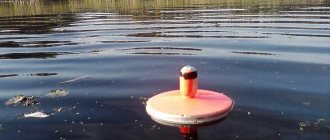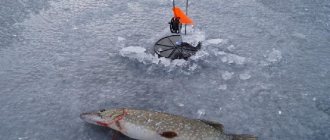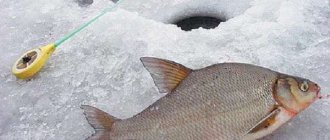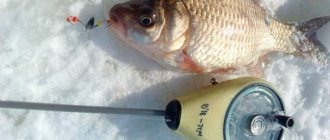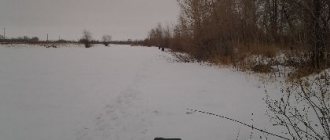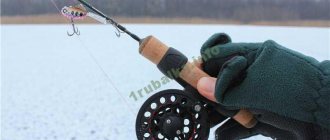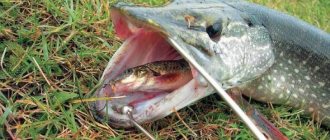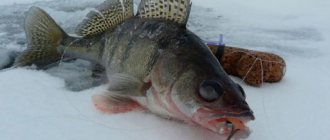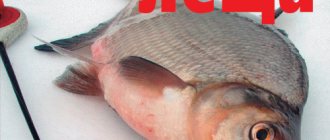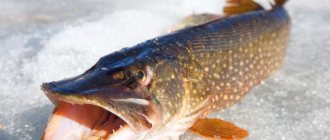A lot of gear and fishing methods have been invented for catching pike in winter. The winter behavior of the toothy is due to the harsh environmental conditions during the cold season. Therefore, for success it is not enough to make the right gear. The predator needs to be found and the right approach must be chosen. It is known that pike can be caught well on the first ice in the spring.
But even in the dead of winter, the toothy one continues, albeit passively, to constantly feed to maintain strength. There is no such thing as absolute no-biting – you just need to find the predator and pick up the right keys. In this article we will look at how to properly catch pike from ice.
Winter fishing for pike
Ice fishing for pike differs from the open water season in the behavioral characteristics of this predator. If in summer and autumn the toothy fish thrives, greedily attacking unwary fish, then in winter it experiences harsh times. Accordingly, pike activity during this period is lower. The habits of toothy fish in winter directly depend on external weather conditions, the oxygen content in the water and the location of the forage fish.
- There is no need to look for short and unpredictable exits, when the predator grabs everything that moves in the water. First of all, the pike is not a raider, but an ambush hunter. Therefore, the point of search tactics during fishing is to find such an ambush.
- With the passage of time and changes in the environmental conditions of the reservoir, the toothy fish changes its location, but the principle of hunting remains the same. The pike stands still or slowly cruises in a certain square, making short and quick throws at the target of attack.
- The behavior of pike in winter is cyclical - the harsher the conditions, the more passive the fish. But even in the most unfavorable times, the predator continues its hunt as usual, it’s just that everything happens slowly and sluggishly.
- Pike conserves energy as a cold-blooded animal; it simply cannot act fiercely and quickly in low temperatures. When fishing in winter, you need to understand these features and not rush when fishing, act measuredly but correctly.
Important nuances of fishing
- Some fishermen are interested in when the pike gets hungry in winter. There is no separate winter pike meal as such. But you can get to the end of the autumn season on the first ice. Towards the end of winter, activity also begins, but this is not zhor. Also, short periods of relatively high activity can be observed in the dead of winter during long thaws (more on this later).
- When does a pike change its teeth in winter is a common question. Throughout the year, gradually, but most actively after spawning. Moreover, this moment occurs differently in specific individuals. So this is not a bite factor at all.
- You should not trust various pike fishing calendars - they are not objective, they only reflect a general theoretical trend. Each body of water (and large ones - in a section of the water area) has its own schedule at different times. It is better to study the trends in the general behavior of the predator, then conduct observations on a specific body of water during the season. Only then will it be possible to confidently know how a pike bites, and only in this place.
- The pike bite in winter is unpredictable. In the most unfavorable conditions you can catch a good fish, but in ideal conditions you can be left without a catch.
- In winter, it is important to reduce the overall speed and intensity of fishing. If in the summer, especially during exploratory travel fishing, everything happens quickly (2-3 casts, transition), then in the winter you need to wait for the slowed-down predator. Therefore, it is important to choose the right fishing location in advance.
Early winter
During a sharp cold snap “already in winter,” which ends with the formation of ice and the cessation of fishing in open water, there is a certain decrease in the autumn hunger for pike, which turns into early winter. This happens because the predator needs some time to adapt to new conditions. Pike in the first ice are, in principle, active - the fish devotes all its energy to storing nutrients for the winter. As soon as the ice is established, the banquet continues.
On the first ice, in November and December, fishing for this fish in winter is very successful. The toothy one pirates in coastal shallows, dumps, edges - almost everywhere. When fishing on clean, transparent ice, you need to move carefully and not make noise - fish can easily be spooked by noise or flickering light and shadow. It’s good if the surface is dusted with snow - the pike’s caution in this case drops. At this time, any pike tackle and bait work.
Glukhozimye
By January, water temperatures drop and oxygen levels drop. In the wilderness, the predator gradually goes deeper and feeds less often and less. But this does not mean that the pike does not feed. She just does it less often and acts slowly, passively. The best way to fish in January is with special girders for deep winter. The structure of the equipment is the same, but thin fishing lines are used.
A metal leash reduces the number of bites significantly, so experienced garrison fishermen do not use it when fishing in the dead of winter, putting up with rare breaks in order to increase the number of bites. By the end of the month, February pike is being caught better - pre-spring changes are felt.
During prolonged thaws, pike can become more active and hunt, even going to depths of less than half a meter. This is due to meltwater getting under the ice and increasing oxygen levels. In small rivers with a large number of springs and gullies on the rifts, the toothy one remains relatively active all winter.
End of winter
Towards the end of February and in March, the toothy activity increases again. Accordingly, on the last ice it is caught well everywhere, including in shallow water. In spring, small baits, live baits or spinners are used for fishing, since it is difficult for fish to push large objects through the digestive tract (due to the development of eggs and milk). Artificial baits are back in business.
Pike fishing in a specific winter month
December is considered the best month for pike fishing. This is the period when these predators walk freely around the pond, hungry and hungry. You should move on the first ice with great caution so as not to fall into the ice hole. The holes must be filled with snow, since everything is clearly visible to the fish through the transparent thin ice. The best time to catch pike is in the first and second ten days of December.
January is a poorer month than December for pike fishing. The bite is especially bad in Central Russia at the end of January. This is the period of wilderness. Thick ice and oxygen deprivation are not good for either the fish or the anglers. This is the low season, when fishermen often come home without any catch. But in January, the lucky ones still manage to sometimes catch a pike using a lure or using a lure. Luck rewards the most patient and persistent winter fishermen.
In February, pike should be caught in the morning or evening. In the first half of the month the bite is better than in the second.
And so, pike can be caught throughout the winter fishing season using a variety of gear. This beautiful fish will bring a lot of happiness to the fisherman if he has a trophy in his fishing backpack. These fish grow very large. In winter, they catch 3-kilogram pikes and larger ones. It’s not a shame to take a photo with such a fish, and catching it will be remembered for a lifetime. It will make a delicious fish soup or fish pie; pike is also good fried.
Views: 722
Oxygen regime and food supply
The habitats of pike in winter directly depend on the oxygen content in the water and the presence of forage fish. The predator prefers to stand in winter where the oxygen saturation of the water is slightly higher than in other parts of the reservoir. At low temperatures, fish cannot efficiently obtain oxygen, so it is simply easier for them to breathe where there is more of this gas in the water.
She also cannot take long hunting trips, since saving energy is the main condition for survival. Therefore, bait thrown under the nose will most likely be happily eaten - a freebie without wasting energy. Correctly identifying pike parking spots in winter is the key to successful fishing. During periods of passivity, the toothy mistake with the choice of fishing location of a couple of meters matters. Therefore, the best results come from anglers who know the trails and places of such stops.
High oxygen levels in water bodies are observed in places:
- Confluence of rivers and streams;
- Underwater springs and springs;
- Lack of rotting mud;
- On the border of a calm current and a fast jet.
Of course, this matters in reservoirs where the oxygen regime noticeably deteriorates in winter. If not, then the pike will stand in its usual places, in the grass and snags. Next, we’ll look at how to find pike in winter.
Where to look for pike in winter
Finding pike in winter is not as straightforward as, for example, when catching pike perch from the ice. The general tendency to strive for greater depth in the wilderness continues, but this is far from the rule. Here, the angler will be helped by a thorough knowledge of the reservoir and remembering the points from which pike, especially large ones, were once caught.
The toothy huntress chooses certain points for her location or walks along her favorite paths. And if such a place becomes vacant (for example, due to fishing), then a new hunter will soon take it. This is especially true for large individuals. Seasoned predators occupy the best places, simply expelling or eating smaller brothers. Such points are remembered and caught again on other fishing trips.
Depth
It is impossible to definitely determine where and at what depth the pike stands in winter. This manifests itself differently in different bodies of water. In January and February, it is better to search deeper water areas, edges and holes with snags, the lower and upper parts of coastal dumps and underwater flooded channels. But even in shallow coastal waters you can find a trophy specimen, especially if there are few deep places in the reservoir or there has been a long-term thaw.
Usually, more or less deep holes with snags, and other suitable places for ambush, are occupied by large individuals - they will simply eat or drive out the pencils. But if such places are not enough with a large population of predators, then in the coastal zone, along with pencils and grass, hard-toothed monsters are also found. They are also present in the vast shallow waters of reservoirs, overgrown with reeds and reeds in summer.
Trophy copies
Where do large pike live in winter? In the best places for an ambush, subject to normal oxygen conditions and an abundance of forage fish. According to their pike hierarchy. If the bottom topography is unknown, then you need to check all promising places, lonely logs under a dump, flooded snags and thickets of vegetation.
If you can look for small and medium-sized robber fish where there are a lot of perch and roach, then for seasoned specimens this is not a factor. Large specimens hunt anything that can fit into their huge mouth, including smaller brothers. To catch a larger trophy in winter, you need to scout out such “nooks”, remember them and check them periodically.
Operating points
Promising places for searching and fishing:
- Coastal thickets of underwater vegetation and reeds, up to half a meter deep.
- In ponds and small reservoirs - on deep flooded channels, edges, any bottom anomalies with shelters.
- In case of poor oxygen conditions - closer to the upper reaches, places of confluence of rivers and streams, near underwater springs and springs.
- Shallow places with strong snags.
- Lonely old snags.
- In rivers and streams there are bends in the channel, bays, calms after the stream behind the cape, spits and ends of islands protruding into the reservoir, deep places near the shore with overhanging trees and bushes.
- Edges, slopes, navels among the depths, entrances and exits from pits.
- In lakes and quarries there are changes in depth, underwater steps, thickets of algae and water lilies, and large boulders.
- In small, shallow, blind ponds (without the confluence of rivers and streams) due to low oxygen levels, the spotted predator may not bite at all, except during periods of the first and last ice, as well as thaws.
Jerky pike fishing on the river in winter
Features of installing girders on the river
For normal fishing, we need at least 7-8 poles; many anglers take more than 20-30 with them. In this case, it is worth studying the fishing rules in the region where you are going to use them; often no more than 10 units are allowed per person.
One of the most promising places for catching catfish on the river is the turn, and here we will talk a little more about the features of installing the gear.
At the turn, one shore is shallow, as a rule, spits are formed there, the second is deep, due to the influence of the current.
The most promising area for catching pike is the spit, since this is where the catfish comes out to hunt, and this is where we begin installing the girders first. It is worth remembering that in winter sand spits can often flood.
Having caught the spit, we move to the opposite section of the river bank (twisting), we begin to install the girders near the entrance to the pit and further, right up to the exit, very often the pike attacks the girders at the entrance and exit. At the same time, fishing for pike perch from the ice can be successful here .
You can often find small turns in the river; as a rule, a backwater forms in front of them, where the current is weak and the bottom is muddy and covered with shell rock; pike love such places.
When moving along the river, carefully monitor the shore; if it is covered with breaks and spits, then there should also be pools that must be fished.
The girders are installed at a distance of 5-7 meters from each other, on the same line or in a checkerboard pattern if pike fishing on the river in winter takes place on the edge and you want to check different depths.
River rig for pike
Zherlitsy
As a rule, fishermen use three types of girders:
- On a wide base - the base is presented in the form of a plastic circle with a diameter of about 25 centimeters, with a cut for passing fishing line. A signal flag and a building on which the coil is located are attached to the base. All parts are collapsible, so this vent is easy to transport. The advantage of such a girder is that the circle completely covers the hole, darkening it (the fish are not so scared) and protecting it from frost; in case of severe minus, snow can be placed on the base.
- A tripod - a rack is a stand on which a reel with a signal flag is placed. The legs are attached to the stand, which are the support of the girder. This vent does not cover the hole, which is why it always needs to be covered with snow, although some vents come complete with special round covers.
- Gears on the rail - consists of the rail itself, a reel and a flag. In order to install it, we need snow or slush from the hole.
fishing line
For girder fishing for pike in winter, only high-quality monofilament fishing line is used. The thickness is 0.25-0.28 mm when catching small pikes weighing 2.5-3 kg and 0.3-0.35 mm for larger individuals.
15-25 m of fishing line is wound on the reel, it all depends on the fishing conditions, if you are going to fish only in shallow waters, then there is no point in winding too much on the reel. But if you plan to catch pike in winter on different rivers, where the depth is different, then reel 30 m.
Sinker
The weight of the sinker depends on the strength of the current and is selected so that the water pressure does not press the baitfish against the ice. If you are fishing in a backwater or backwater where there is practically no current, you can use a rig with a sliding sinker (Fig. 1).
Fig 1
In cases where we need to use heavy ones, over 20 grams. sinkers, sliding installation will not work, because when biting, the fish will immediately feel the additional weight of the equipment. In this case, it is more appropriate to use the installation shown in Fig. 2. This installation is also more effective in areas strewn with snags.
Fig 2
Habit
In order for your bait to be active and lure the catfish for as long as possible, the hook is strung in front of the dorsal fin. Also, live bait can be attached behind the lip and behind the dorsal fin. When fishing in the current, it makes sense to attach live bait with two hooks: we attach a tightly tied fin behind the lip, and behind the dorsal fin, a hook that slides freely along the hook. In this case, even if our live bait starts to fall asleep, the current will still move it.
Hooks
Hooks must be of high quality and sharp. You can use single doubles and tees; personally, I prefer tees No. 6-8.
Pike fishing on the river in winter, features of choosing live bait
In order for your bait to be active and lure the catfish for as long as possible, the hook is strung in front of the dorsal fin. Also, live bait can be attached behind the lip and behind the dorsal fin.
Store-bought bait will also work, just one piece of advice: catching pike in winter with live bait, which is not typical for a given river, may not give the expected result.
If you are going to catch live bait directly on the river, then you need:
- Perch;
- Roach;
- Rudd;
- Small crucian carp;
- Guster;
- Bleak is only for fishing in shallow waters.
- Goby;
- Ruff;
A little about the features of hooking
A flag will signal us about a catfish bite, but we don’t need to mindlessly run to the girder, the fish hears everything perfectly well under water, and let go of our bait. As a rule, a pike, having swallowed live bait, goes with it to a certain distance. And only after stopping, he begins to swallow. So, you need to hook when the pike stops reeling in the line. Unfortunately, this does not always guarantee success, since the catfish can move away and stand for several minutes without swallowing the bait. But there's nothing you can do about it.
If pike fishing on the river in winter takes place in snags, then you need to hook it immediately when biting, and limit the stock of fishing line for free play to 2-3 m by throwing a loop on the reel.
Read more about catching pike with girders here .
When does pike bite in winter?
The success of winter pike fishing is influenced by many factors, and it is theoretically impossible to predict the bite. A specific set of factors applies only to a specific body of water. In addition to oxygen, biting activity is also affected by pressure, wind, and temperature. But the difficulty is that this happens differently everywhere. Moreover, for some individuals in this reservoir the change in conditions has an activating effect, while for others it is the opposite.
On some reservoirs you can set your watch by the predator’s exits, on others the pike bite in winter is completely unpredictable, on others it bites slowly throughout the day. Therefore, it is important to know the specific body of water and the behavioral characteristics of the predator in it. It is impossible to say exactly what time pike is caught in winter. A trend that, again, is far from a rule: at the beginning of winter and during the first ice, grips occur at any time, often most actively - in the late morning or early evening.
When active, fishing at night can also be effective. But in the dead of winter, the fish are passive; they bite sluggishly during the day, when it is already light. Or it bites at certain times, and this schedule changes smoothly as the winter progresses. In some places, when fishing for pike from ice, the classic statement also works: when atmospheric pressure increases, the predator tries to stay in depth, and when it decreases, it tries to stay in shallow areas.
About pike habits
Pike, unlike pike perch or pike perch, is not a schooling fish. I caught one and that’s it: look for a new pike shelter, a new fishing spot. (For comparison, I’ll say that if you attack a school of perch, you can count on catching several specimens.) In addition, a school is always easier to detect than one fish.
When a predator is well-fed or under the influence of unfavorable natural factors, rousing it and forcing it to grab the bait is not an easy task. An angler, accustomed to the fact that pike perch shows itself immediately after one or two lifts of the spoon, will stubbornly look for new places, drill many new holes and practically never return to the old ones. This is his main mistake, which nullifies all the work expended.
If there is no pike zhor in the pond at the moment of trolling, then the following happens: the predator, immediately reacting to the play of the lure that has entered its territory, closely watches the bait, but does not attack it. And if the angler fails to awaken its hunting instinct with a non-standard technique of playing a spoon, then there will be no catch.
How to catch pike in winter
The main winter methods of catching pike are jigging and vertical lures. There are many secrets and tricks of winter fishing for pike; they are outlined in the relevant articles on our website (about specific fishing methods).
An article about winter gear for pike.
Pike girders (flags, supplies) are used all winter. With such a rig it is easier to catch the passive toothy robber of mid-winter. When fishing at the beginning and end of winter, for an active predator, artificial baits work well:
- Spoons;
- Ratlins (winter wobblers, vibes);
- Balancers;
- Edible rubber and silicone, winter jig;
- Cicadas;
- Jigs with fry and tyrants with a piece (or whole) fish attached.
Read more about this in the article on winter pike lures. It is impossible to answer unequivocally what pike likes in winter. In different conditions, the predator will react to the angler’s offers in different ways. The most popular winter fishing for pike is with girders. Therefore, several tackles and baits will be required, especially if the tastes of the predator are unknown, and the reservoir is visited rarely or for the first time. The answer can only be found experimentally during the fishing process, by drilling a hole and throwing out the tackle.
Equipment for ice fishing for pike
For successful pike fishing, you need not only to choose the right fishing spot and select catchy baits. Great attention must be paid to equipment, because pike is a strong and large fish, and catching it requires good skill and strong gear.
Pike and winter fishing rod
Winter fishing rod
Pike is fished with a winter fishing rod more than thirty centimeters long. The fishing rod should be strong and without nodding. But if a fisherman is going to catch small pike, then it is still necessary to put a nod. The line must be monofilament. Its thickness depends on the weight of fish the winter fisherman is going to catch, and varies from 0.2 to 0.4 millimeters. After all, when fishing, a good pike can bite, so it’s worth using a strong, thicker fishing line made by a reliable fishing tackle manufacturer.
Some fish with braided line, but it has a disadvantage: in winter water it becomes very visible and therefore fewer fish are usually caught with it in winter, but many years of observation by experienced fishermen. You can buy any reel, but a reel is still better. Any hooks will do, as long as they are large, reliable and durable. You definitely need a metal leash, preferably tungsten, otherwise there is a high probability that the pike will bite through even a thick fishing line with its sharp teeth.
There are many baits; the fisherman chooses them according to his taste and desire. If you are going to lure pike, then spinners from six to twelve centimeters are best suited. The balancer is also chosen larger, from five to eight centimeters in length. Very good baits are completely similar in color and size to the juvenile fish that live in the area. The most commonly used baits made from silicone are jigs, vibrotails and twisters.
Fishing using a rattlin with a fastening in the middle of the fish’s body is becoming more and more catchy. Rattlin has an advantage over the balancer, as it can vibrate the water and thereby attract a predator.
Zherlitsy
If a winter fisherman goes to catch pike on a girder, he needs real bait, not artificial bait. The best bait for bait is such fry as bleak, ruffe, perch, sorozhka, sometimes gudgeon and crucian carp are used.
About
Lure
Bait for pike is rarely used in winter. Search is often used rather than luring. Feeding a predator is advisable when fishing in large areas of reeds in order to quickly lure the toothy one from the thickets to the windows with gear. Animal components are used as feeding - fish, shrimp, fresh blood (pork or bovine), store-bought bait for predators. If there is a lot of small fish in the fishing area, then you can lure it with vegetable bait, and a toothy robber will also be suitable for activity.
Additional equipment
A yawner and an extractor will help you remove the hooks from the toothy mouth of the predator. A depth gauge, echo sounder or under-ice camera will make it easier to find cool spots on an unfamiliar body of water. Every spinner should have an unhooking hook in his arsenal, since the classic place for fishing is snags and thickets. Both when fishing with lures and when jigging with lures, a thermos with hot tea will not hurt, which will make the hours spent on the ice more comfortable and more fun.
